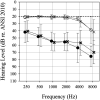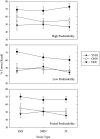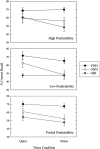The Influence of Noise Type and Semantic Predictability on Word Recall in Older Listeners and Listeners With Hearing Impairment
- PMID: 35973100
- PMCID: PMC9913215
- DOI: 10.1044/2022_JSLHR-22-00075
The Influence of Noise Type and Semantic Predictability on Word Recall in Older Listeners and Listeners With Hearing Impairment
Abstract
Purpose: A dual-task paradigm was implemented to investigate how noise type and sentence context may interact with age and hearing loss to impact word recall during speech recognition.
Method: Three noise types with varying degrees of temporal/spectrotemporal modulation were used: speech-shaped noise, speech-modulated noise, and three-talker babble. Participant groups included younger listeners with normal hearing (NH), older listeners with near-normal hearing, and older listeners with sensorineural hearing loss. An adaptive measure was used to establish the signal-to-noise ratio approximating 70% sentence recognition for each participant in each noise type. A word-recall task was then implemented while matching speech-recognition performance across noise types and participant groups. Random-intercept linear mixed-effects models were used to determine the effects of and interactions between noise type, sentence context, and participant group on word recall.
Results: The results suggest that noise type does not significantly impact word recall when word-recognition performance is controlled. When data from noise types were pooled and compared with quiet, and recall was assessed: older listeners with near-normal hearing performed well when either quiet backgrounds or high sentence context (or both) were present, but older listeners with hearing loss performed well only when both quiet backgrounds and high sentence context were present. Younger listeners with NH were robust to the detrimental effects of noise and low context.
Conclusions: The general presence of noise has the potential to decrease word recall, but type of noise does not appear to significantly impact this observation when overall task difficulty is controlled. The presence of noise as well as deficits related to age and/or hearing loss appear to limit the availability of cognitive processing resources available for working memory during conversation in difficult listening environments. The conversation environments that impact these resources appear to differ depending on age and/or hearing status.
Figures







Similar articles
-
Word recognition for temporally and spectrally distorted materials: the effects of age and hearing loss.Ear Hear. 2012 May-Jun;33(3):349-66. doi: 10.1097/AUD.0b013e318242571c. Ear Hear. 2012. PMID: 22343546
-
Predictive Sentence Context Reduces Listening Effort in Older Adults With and Without Hearing Loss and With High and Low Working Memory Capacity.Ear Hear. 2022 Jul-Aug 01;43(4):1164-1177. doi: 10.1097/AUD.0000000000001192. Epub 2022 Jan 4. Ear Hear. 2022. PMID: 34983897 Free PMC article.
-
Speech Perception in Noise and Listening Effort of Older Adults With Nonlinear Frequency Compression Hearing Aids.Ear Hear. 2018 Mar/Apr;39(2):215-225. doi: 10.1097/AUD.0000000000000481. Ear Hear. 2018. PMID: 28806193 Free PMC article.
-
The Association Between Cognitive Performance and Speech-in-Noise Perception for Adult Listeners: A Systematic Literature Review and Meta-Analysis.Trends Hear. 2017 Jan-Dec;21:2331216517744675. doi: 10.1177/2331216517744675. Trends Hear. 2017. PMID: 29237334 Free PMC article.
-
Performance Monitoring and Cognitive Inhibition during a Speech-in-Noise Task in Older Listeners.Semin Hear. 2023 Apr 28;44(2):124-139. doi: 10.1055/s-0043-1767695. eCollection 2023 May. Semin Hear. 2023. PMID: 37122879 Free PMC article. Review.
References
-
- Akeroyd, M. A. (2008). Are individual differences in speech reception related to individual differences in cognitive ability? A survey of twenty experimental studies with normal and hearing-impaired adults. International Journal of Audiology, 47(Suppl. 2), S53–S71. https://doi.org/10.1080/14992020802301142 - PubMed
-
- American National Standards Institute. (1987). ANSI S3.39 (R2012). American National Standard Specifications for Instruments to Measure Aural Acoustic Impedance and Admittance(Aural Acoustic Immittance).
-
- American National Standards Institute. (2004). ANSI S3.21 (R2009). American National Standard Methods for Manual Pure-Tone Threshold Audiometry.
-
- American National Standards Institute. (2010). ANSI S3.6, American National Standard Specification for Audiometers.
-
- Assmann, P. , & Summerfield, Q. (2004). The perception of speech under adverse conditions. In Speech Processing in the Auditory System (Vol. 18, pp. 231–308). Springer. https://doi.org/10.1007/0-387-21575-1_5
Publication types
MeSH terms
Grants and funding
LinkOut - more resources
Full Text Sources

